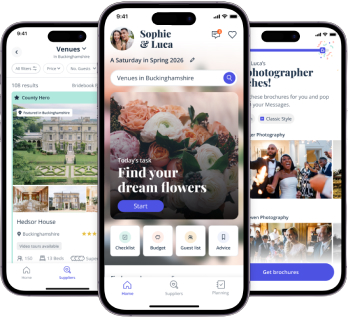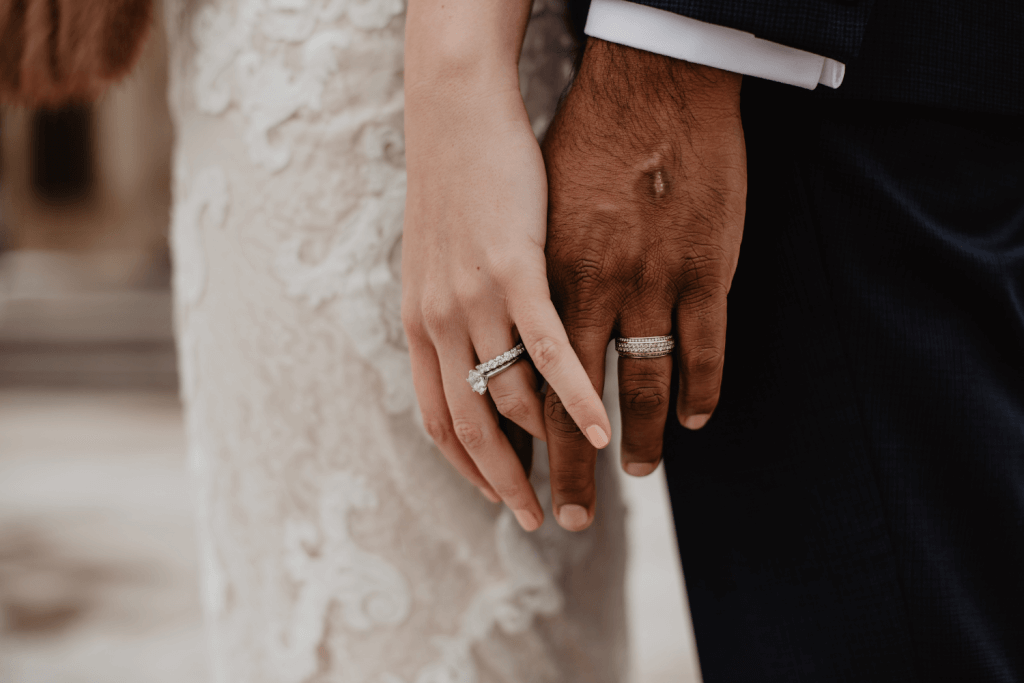
Wedding bands may seem like a small part of your overall wedding day in and of itself. But, their symbolism, value and impact can’t be understated.
Unlike most other wedding details, this little ring stays with you long after the big day is over. It’s the piece you’ll look at every day, the one that will remind you of the vows you made, the adventures you’ve shared, and all the memories yet to come. So while it may be small, its meaning (and its place in your life) couldn’t be bigger.
Read on to learn everything you need to know about wedding bands. We cover everything from where to wear a wedding band, to the metals, finish, and style that go into each piece. Plus, we cover 5 top tips to help you pick the perfect ring, and some general care and maintenance tips to help it look its best. Good luck!
What is a wedding band?
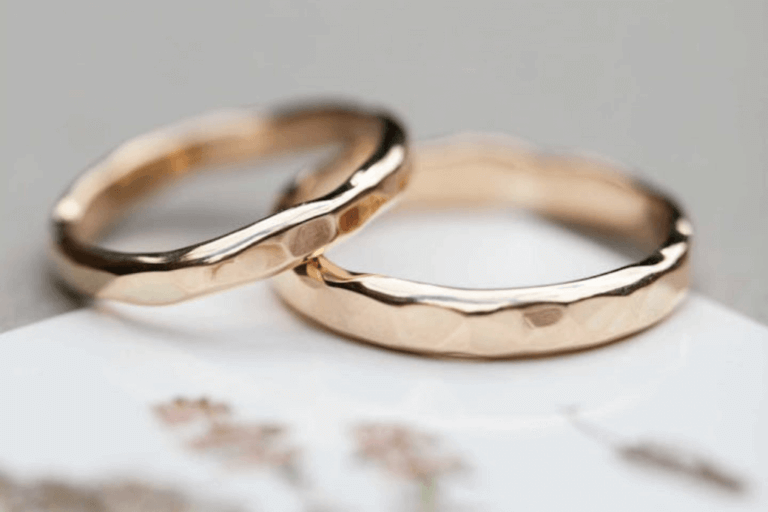
Your wedding band, or marriage ring, is the ring you receive on your wedding day from your spouse. It’s used as a symbol of commitment and love between you and your new partner.
Wedding bands are different to engagement rings. Engagement rings are usually more eye-catching, with a focus on gemstones like diamonds or intricate mental work. They’re also traditionally only worn by one partner. However, people of all relationship types and gender identities can of course wear engagement rings.
Wedding bands, on the other hand, are worn by both members of the couple and are usually simpler and more understated. They focus on durability and comfort for everyday wear, and are intended as a lasting reminder of your partnership. They’re worn daily and serve as a reminder of the vows you made, staying with you as a little piece of your wedding day for years to come.
Which finger do I wear a wedding band on?
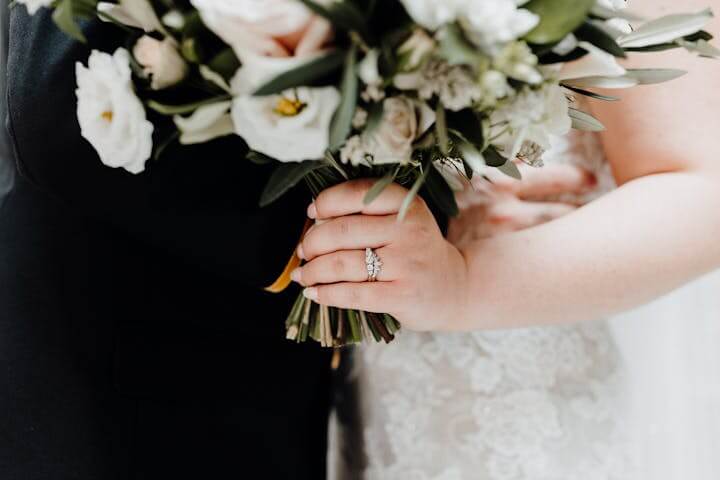
Wedding bands are traditionally worn on the ring finger (fourth finger) of the left hand. If you wear any other rings on that hand, for example, an engagement ring, you should wear your wedding band underneath that ring. This ensures it’s as close to your heart as possible (and it’s the most traditional way to wear it).
However, in some cultures, people wear their wedding bands on the right hand. Equally, a lot of couples choose to wear their wedding band on their little finger, especially if they wear a signet ring.
Honestly, there’s no “right” way to wear a wedding band — it’s all about what feels right and special to you both.
To compare this to which finger you should wear your engagement ring on, check out our dedicated article.
Everything you need to know about wedding bands
Keen to learn more about the different types of wedding bands? Read on to learn everything you need to know about these beautiful and symbolic rings.
Metals
There are a range of metals to choose from when it comes to wedding bands. The following are the most popular ones…
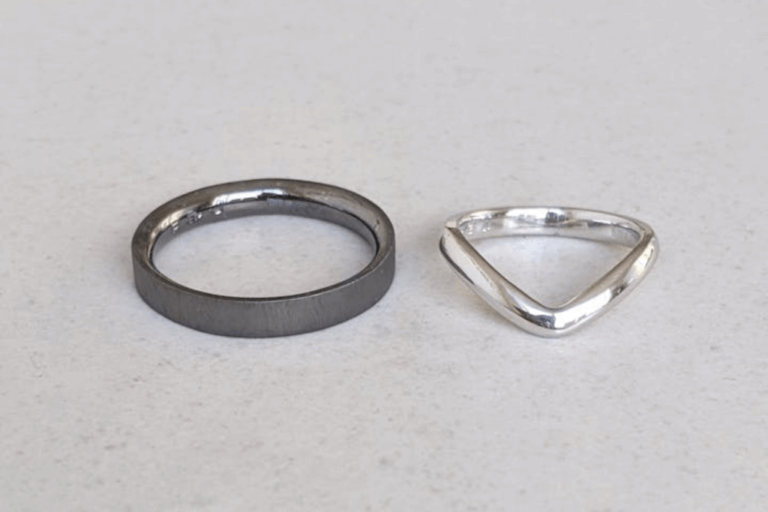
- Gold. Gold is a classic choice for a wedding band. It’s beautiful, durable, and comes in a few different shades to suit any style! You’ve got yellow gold, which has that warm, traditional feel; white gold, which is sleek and modern; and rose gold, which adds a romantic, blush-toned twist. Gold is also a versatile metal, so you can choose different levels of purity depending on how durable you want it to be. For example, 14, 16, or 18 karat.
- White gold. We’ve separated white gold out from the above due to the specialist care it needs. White gold gets its gold appearance from a thin layer of rhodium plating, which gives it that bright, shiny, silver-like finish. Over time, the rhodium layer can wear off, especially if you wear your ring daily (which, let’s face it, most of us do!). To keep white gold looking its best, you’ll need to get it re-plated every few years. You should factor this maintenance into the overall cost of your ring.
- Platinum. Platinum is a fantastic choice if you’re looking for something that’s naturally white, incredibly strong, and hypoallergenic. Unlike white gold, platinum doesn’t need any plating to keep its colour, so it’s low-maintenance while still offering a luxurious, bright finish. It’s also noticeably heavier than gold and much more durable. Perfect for those who are heavy-handed.
- Silver. Silver gives you the same look as white gold and platinum at a fraction of the cost. While it’s not as durable as other metals, it’s a great choice if you’re looking for something stylish and budget-friendly. Bear in mind that to keep silver looking its best, it may need occasional polishing and maintenance.
- Untraditional metals. Untraditional metals like titanium, iron, and tungsten are perfect if you’re after something a bit different with a modern edge. They all come with unique pros and cons, so be sure to thoroughly research these modern metals if you’re after something a little different.
Stones
Although traditional wedding bands are usually plain, many couples choose to add stones for a touch of sparkle or a bit of personality. Read on to learn more about having stones in your wedding band.
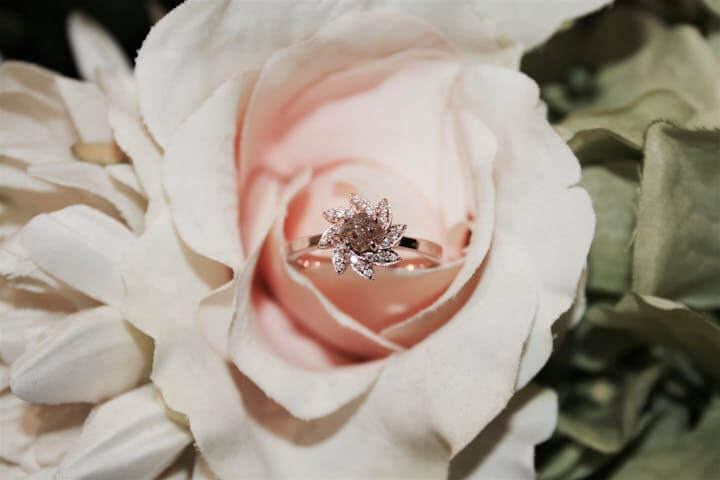
- Diamonds. Diamonds are the classic go-to if you want a bit of sparkle in your wedding band. They’re incredibly durable and perfect for everyday wear. You could go with tiny diamonds set around the band for a subtle, elegant shimmer or a single diamond if you want a focal point that’s not too over-the-top.
- Coloured gemstones. If you like a pop of colour with your bling, consider coloured gemstones! Sapphires, emeralds, rubies, and even birthstones are a beautiful way to add a personal touch to your wedding band. Just keep in mind that some gemstones are a bit softer than diamonds, so they might need a little extra care if you’re wearing your band every day.
- Natural stones. Natural stones like turquoise, pearl, and moonstone can add a unique, earthy vibe to your wedding band. However, these stones are often substantially softer than diamonds or other coloured gemstones, so do your research and make sure you’re prepared for the maintenance to come.
- Other natural materials. Lots of jewellers now offer services where they can capture other organic matter in resin and incorporate it into your wedding band for a truly one-of-a-kind piece. For example, sand from a favourite beach, a pressed flower from a memorable bouquet, or even a bit of wood from a meaningful forest. This option is perfect for couples who want to carry a piece of their shared history or a special memory with them every day.
Width
The width of your wedding ring is also important. This detail contributes a lot to the look, style, and feel of your ring, so it’s important to consider all your options when picking a width.
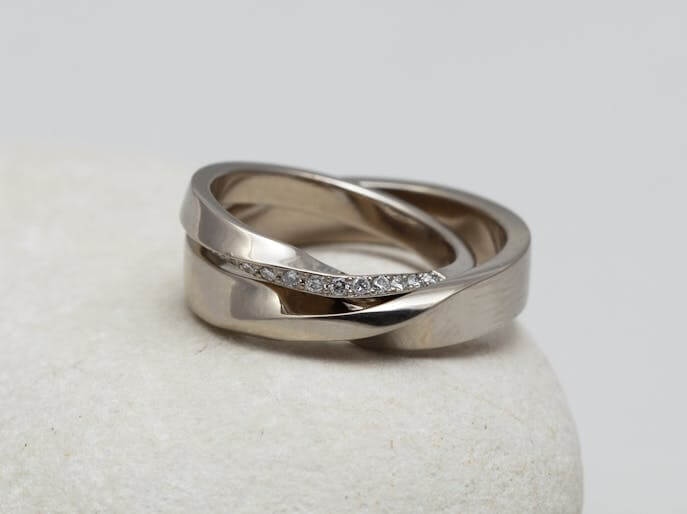
- Thin. Thin bands are definitely the trend at the moment. They’re dainty, beautiful, and perfect for a minimalist look. Thin bands are great if you want something subtle that won’t overpower your engagement ring or if you’re just a fan of that delicate, barely-there vibe. However, thin bands aren’t as durable as thick rings, and can bend or even snap with everyday weather.
- Medium width. A happy medium (pun not intended) between thin and thick bands, medium width bands offer the best of both worlds and a classic look. They’re substantial enough to feel sturdy and durable for everyday wear, yet not too bold or overpowering.
- Thick. Chunky bands look best when worn alone or paired with a simple engagement ring. Thick bands are bold and eye-catching, perfect if you want a wedding band that stands out on its own. They’re also super durable and can handle everyday wear without worry, making them ideal for someone who leads an active lifestyle or works with their hands.
Style
The style of your wedding band will make a huge difference to the overall vibe of your ring, so it’s worth thinking about what really speaks to you. Consider the below when picking the style of your wedding band:
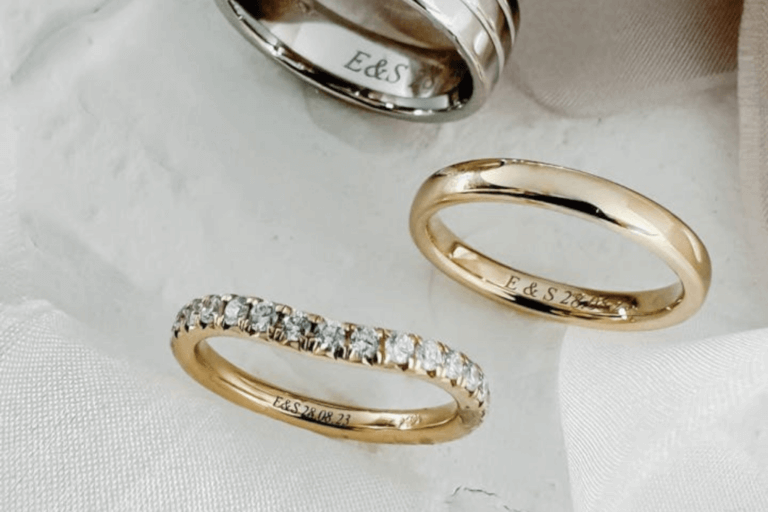
- Traditional. Traditional wedding bands are the traditional, rounded wedding bands we know and love. They have a slight curve to the top and a smooth, polished finish that gives off an elegant, timeless feel. This style is perfect if you’re a fan of simplicity and want a ring that will look classic forever.
- Slight. A slight wedding band is a more delicate version of the traditional style. It’s slim, dainty, and has just a hint of curve, perfect if you want something subtle but still classic. Slight bands are ideal if you’re after that “barely there” look or if you’re planning to stack multiple rings together.
- Edge. Edge rings have a flatter, more modern style with a smooth top and a defined edge, giving them a sleek, contemporary look. This style is perfect if you want something a bit more structured but still understated.
- Wish. If you’re lucky enough to have an oval, marquise, or just downright big engagement ring gemstone that doesn’t quite fit with a straight band, a wishbone or “wish” band might be your new best friend! These bands have a subtle V-shape or curve, allowing them to sit perfectly around your engagement ring, creating a lovely, cohesive look.
- Curved. Slightly softer than a wish, curved wedding bands are designed to gently hug your engagement ring without a deep V shape. They’re ideal if your engagement ring has a setting that sits low or has a bit of an edge to it.
- Art deco. Art deco rings are a dream if you love vintage glam and intricate designs. Think bold geometric patterns, milgrain details, and lots of character. Art deco bands often feature tiny stones or engraved patterns that give them a unique, glamorous look straight out of the Roaring Twenties. They’re perfect if you want something that feels like an heirloom or if you just love a bit of old-school charm with a modern twist. They come in lots of different shapes and styles, and look stunning either solo or paired with a simple engagement ring.
- Twisted. A braided or ‘twisted’ wedding band style is known to present unity and togetherness — what could be more perfect for a wedding band? These rings usually have two or three strands intertwined, creating a look that’s both elegant and full of meaning. They add a touch of texture and look especially lovely with plain or slightly curved engagement rings.
- Floral. If you’re looking for something whimsical and beautiful, a floral wedding band might be just the thing. Floral bands feature delicate engravings or embossed patterns of leaves, vines, or flowers, adding a romantic, nature-inspired touch to your ring. Floral bands can be intricate and detailed, or bold and colourful, making them a lovely choice for a standalone piece or a charming addition next to a simple engagement ring.
- Filigree. Filigree bands are all about delicate, intricate metalwork that adds an old-world charm to your wedding band. Think swirling patterns, lace-like designs, and lots of tiny details that give your ring a vintage feel. Filigree is perfect if you love the look of something ornate and timeless. It’s like wearing a tiny piece of art on your finger.
- Engraved. For an ultra personal touch, engraved bands are the way to go. You can add initials, a meaningful date, a short phrase, or even a tiny symbol that has special meaning to you and your partner. It’s like a little secret message you carry with you every day, acting as a constant reminder of your special day.
Finish
The finish of your wedding band is just that — the finishing touch that pulls everything together. Below is a list of the most popular finishes for wedding bands you might want to consider.
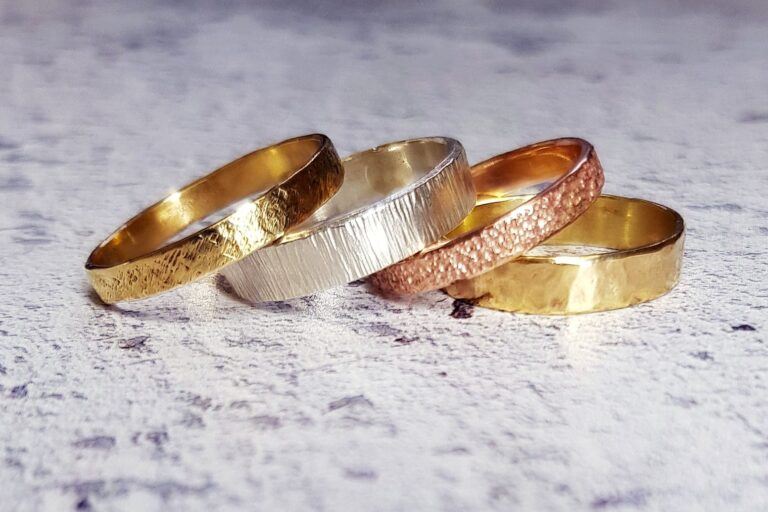
- Polished. A polished finish is a traditional, smooth, high-shine finish that gives your band a classic, mirror-like look. It’s sleek, timeless, and definitely makes a statement.
- Satin. The satin finish is a smooth, semi-matte finish that offers a soft, elegant glow without the full shine of a polished band. It’s a great middle ground if you like a bit of sheen but want something more understated. Plus, it tends to hide little scratches well, so is brilliant for those who are heavy-handed.
- Matte. Matte finishes give your band a soft, velvety look without any reflection, so it feels effortlessly cool and sophisticated. It’s a modern and understated look, perfect for those who like something a little different.
- Brushed. Brushed finishes have a subtle texture with fine, directional lines that give the band a satin-like look with a bit of extra character. It’s ideal if you want a little more depth and texture without going for a full matte.
- Hammered. Hammered finishes bring a touch of rustic charm to your ring, with small, uneven dimples that create a unique, textured surface. Each “hammer” mark catches the light in a slightly different way, giving the metal a natural, organic look. This finish is perfect if you’re after something that feels handcrafted and one-of-a-kind. It’s rugged yet refined.
Top tips for wedding band shopping
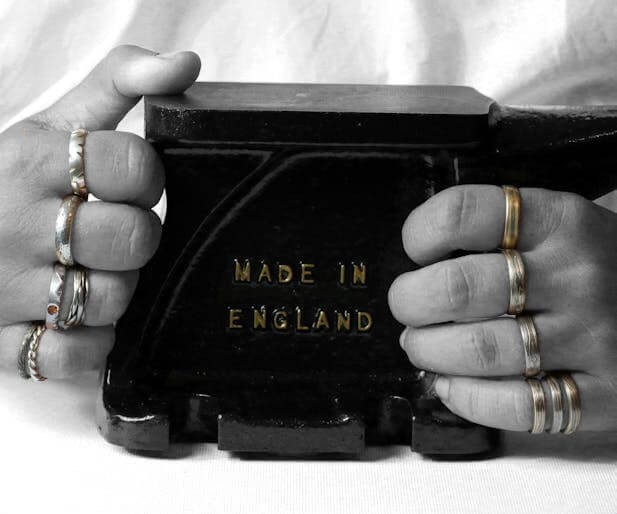
Keep these top tips in mind when you and your partner go wedding band shopping to find your perfect rings:
1) Keep your lifestyle in mind
Wearing your ring every day means it’ll impact every part of your lifestyle. If you’re an active person, or if you work a lot with your hands, you’ll want a ring that can stand up to the wear and tear.
Equally, if you’re a little heavy-handed, durable metals like platinum or titanium, or even a hammered or matte finish, can help keep scratches at bay. For something extra tough, consider a comfort-fit band. It’s made to feel smooth and easy on your finger, so you can wear it all day, every day, with no fuss.
2) Set a budget beforehand
Wedding bands can be pricey, especially ones made of platinum or white gold, or those with inset stones. Having a budget in mind before you start ring shopping can help you stay focused and avoid getting swept away by options that are outside your price range.
While some options can definitely add up, there are beautiful wedding bands out there for every budget. And don’t be afraid to try on a few styles slightly outside your range — you might just find “the one” that’s worth the splurge!
3) Think about future ring stacks
Eternity bands are traditionally given after the birth of a baby, to celebrate a milestone anniversary, or just because you feel like adding a little extra sparkle. If you’re already envisioning a ring stack for future occasions, go for a band that will play nicely with others. Thin, simple bands are perfect for building a stack, and they’ll let you add anniversary bands or other special rings over time.
4) Check the comfort
Sure — your wedding ring looks great on. But, can you pick up a handbag, use a pair of scissors, type on your keyboard, or even hold a pen without feeling like you need to take it off?
Comfort is key when it comes to a ring you’ll wear daily. Try doing a few everyday tasks while wearing it. Wiggle your fingers, make a fist, and see how it feels. This ring is going to be on 24/7, so you need to be happy with it.
5) Make it a date
Are there any other wedding activities you and your partner need to sort together? If so, you could make a fun day of this escapade, combining wedding band shopping with a few other to-dos. Check out that new coffee shop, go try on rings, and then pop by your cake tasting or suit fitting afterwards.
Or, if it’s a more relaxed day, finish off with a celebratory lunch or even a quick toast to ticking another thing off the wedding list! Turning it into a mini date makes it feel special, and it’s a lovely way to make memories out of these pre-wedding moments.
Don’t forget to take some cute photos along the way!
Caring for your wedding bands
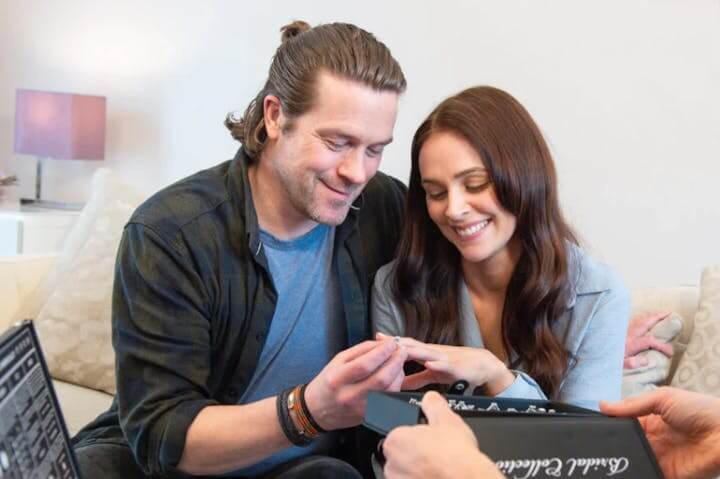
Caring for your wedding bands will depend largely on the type of metal, style, finish, and thickness of the band. Speak to your jeweller for specialist care information related to your specific rings.
General advice that applies to all rings can include:
1) Use a gentle soap and soft cloth to polish
If you wear something every day, you need to clean it — that’s a fact. A dirty ring can appear dull, scratched, and may even damage the ring over time.
Use a mild soap like baby shampoo or fairy liquid in conjunction with a soft bristled toothbrush and a soft cloth to polish. Be sure to wash the soap off with fresh, clean water, before drying and polishing gently.
2) Watch for perfume and hand cream build up
Perfume and hand cream can build up over time. But, not washing it off effectively may tarnish or damage your ring. Take your ring off once a month to give it a thorough clean. Consider washing it twice a month if you’re especially attentive with your hand cream or have a ring made of silver, white gold, or with precious stones.
3) Take it for an annual MOT
Taking your wedding ring for an annual once-over with your jeweller can help keep it looking as good as new and catch any potential issues before they become bigger problems.
Your jeweller can check for loose stones, worn prongs, and give it a professional clean and polish that at-home care just can’t match. Think of it as an investment towards keeping your band beautiful for the long haul. Plus, it’s always nice to see it shine like it did on day one.
Pick your perfect wedding band with Bridebook
Your wedding ring is an everlasting symbol of your love. As a result, you want something that not only looks stylish, but is also designed to stand the test of time (no matter what you throw at it). Whether you’re heavy-handed, have a light touch, are committed to weekly cleaning, or prefer the natural look, there are wedding bands to suit every personality and lifestyle.
Finding your dream wedding band is simple with Bridebook. You can effortlessly browse our brilliant range of jewellers, message the ones who take your fancy, save your favourites in a handy ‘scrapbook’, and keep your ideas all in one place. Sign up for a free account today and start your wedding planning journey!

